Corporate Governance Weakness Analysis in Australian Accounting
VerifiedAdded on 2023/06/08
|8
|2435
|201
Report
AI Summary
This report provides an analysis of a case scenario involving a medium-sized company listed on the Australian Securities Exchange (ASX), focusing on the ethical and corporate governance implications of a discussion between the CEO and a non-executive director regarding potentially misrepresenting profit figures. The report explores various corporate governance theories, including agency, stewardship, and stakeholder theories, to assess the weaknesses in the company's governance structure. It highlights the importance of ethical conduct, transparency, and adherence to regulatory standards in financial reporting, concluding that a balanced approach incorporating multiple governance theories is essential for effective corporate governance and maintaining stakeholder trust. The analysis emphasizes the need for companies to prioritize ethical practices and transparent communication to ensure long-term sustainability and stakeholder satisfaction.
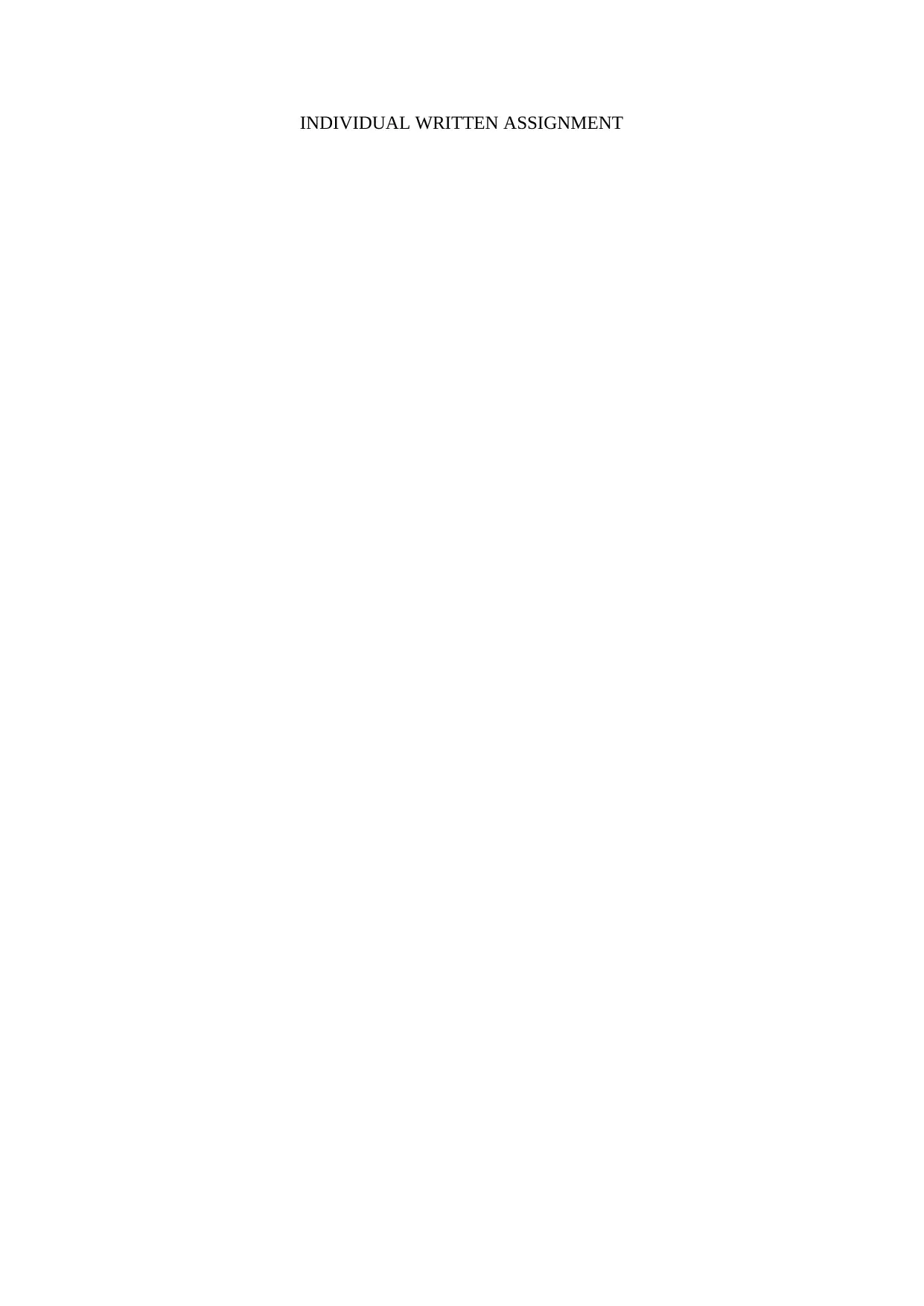
INDIVIDUAL WRITTEN ASSIGNMENT
Paraphrase This Document
Need a fresh take? Get an instant paraphrase of this document with our AI Paraphraser

TABLE OF CONTENTS
Introduction................................................................................................................................3
Analysis of case scenario...........................................................................................................3
Corporate governance and effective corporate governance under different theories.............3
Corporate governance........................................................................................................3
Effective corporate governance under different theories...................................................3
Analysis of situation faced by company and weakness of in their corporate governance.....5
Analysis of situation of company.......................................................................................5
Weakness in corporate governance of company................................................................6
Conclusion..................................................................................................................................7
References..................................................................................................................................8
Introduction................................................................................................................................3
Analysis of case scenario...........................................................................................................3
Corporate governance and effective corporate governance under different theories.............3
Corporate governance........................................................................................................3
Effective corporate governance under different theories...................................................3
Analysis of situation faced by company and weakness of in their corporate governance.....5
Analysis of situation of company.......................................................................................5
Weakness in corporate governance of company................................................................6
Conclusion..................................................................................................................................7
References..................................................................................................................................8
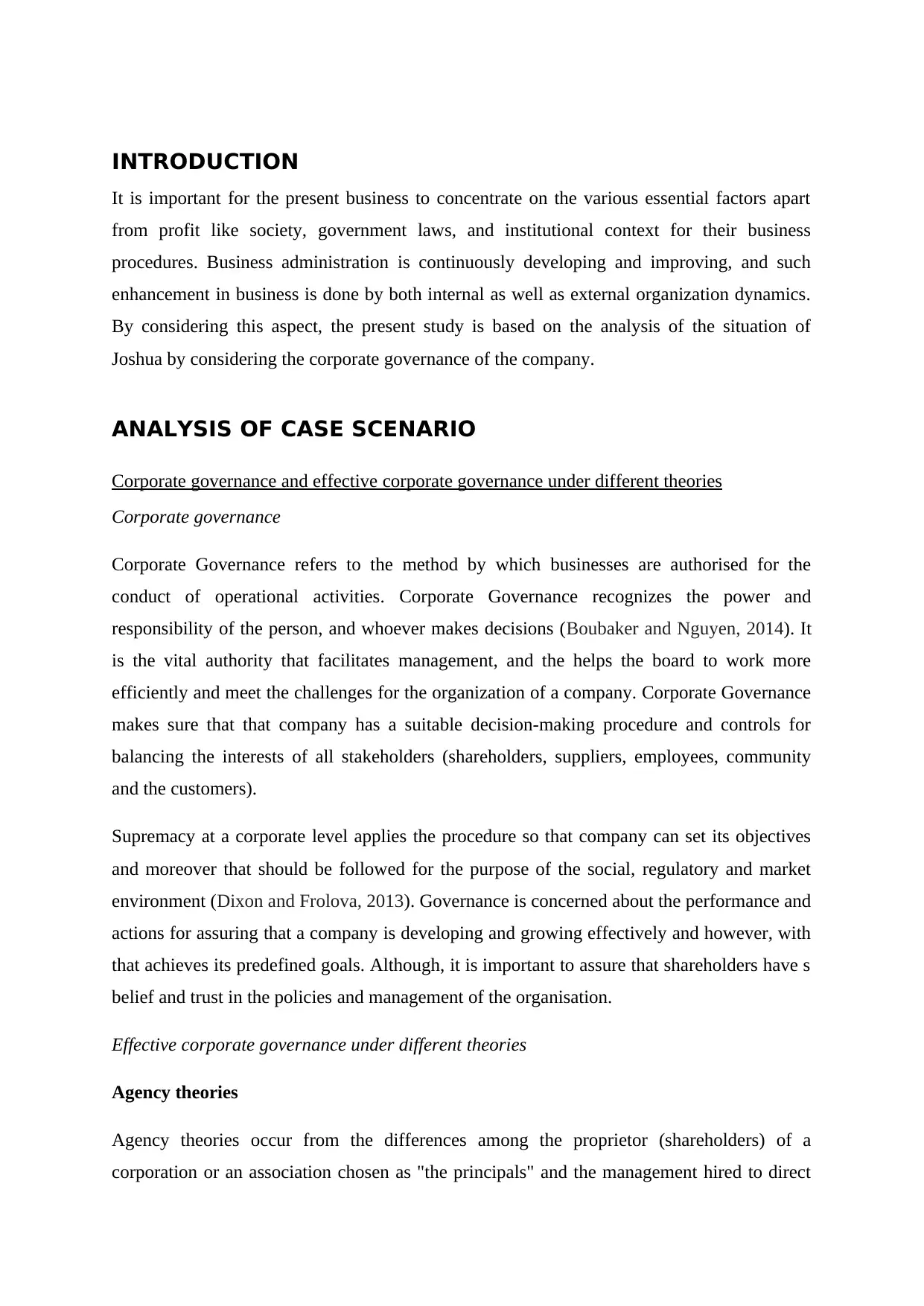
INTRODUCTION
It is important for the present business to concentrate on the various essential factors apart
from profit like society, government laws, and institutional context for their business
procedures. Business administration is continuously developing and improving, and such
enhancement in business is done by both internal as well as external organization dynamics.
By considering this aspect, the present study is based on the analysis of the situation of
Joshua by considering the corporate governance of the company.
ANALYSIS OF CASE SCENARIO
Corporate governance and effective corporate governance under different theories
Corporate governance
Corporate Governance refers to the method by which businesses are authorised for the
conduct of operational activities. Corporate Governance recognizes the power and
responsibility of the person, and whoever makes decisions (Boubaker and Nguyen, 2014). It
is the vital authority that facilitates management, and the helps the board to work more
efficiently and meet the challenges for the organization of a company. Corporate Governance
makes sure that that company has a suitable decision-making procedure and controls for
balancing the interests of all stakeholders (shareholders, suppliers, employees, community
and the customers).
Supremacy at a corporate level applies the procedure so that company can set its objectives
and moreover that should be followed for the purpose of the social, regulatory and market
environment (Dixon and Frolova, 2013). Governance is concerned about the performance and
actions for assuring that a company is developing and growing effectively and however, with
that achieves its predefined goals. Although, it is important to assure that shareholders have s
belief and trust in the policies and management of the organisation.
Effective corporate governance under different theories
Agency theories
Agency theories occur from the differences among the proprietor (shareholders) of a
corporation or an association chosen as "the principals" and the management hired to direct
It is important for the present business to concentrate on the various essential factors apart
from profit like society, government laws, and institutional context for their business
procedures. Business administration is continuously developing and improving, and such
enhancement in business is done by both internal as well as external organization dynamics.
By considering this aspect, the present study is based on the analysis of the situation of
Joshua by considering the corporate governance of the company.
ANALYSIS OF CASE SCENARIO
Corporate governance and effective corporate governance under different theories
Corporate governance
Corporate Governance refers to the method by which businesses are authorised for the
conduct of operational activities. Corporate Governance recognizes the power and
responsibility of the person, and whoever makes decisions (Boubaker and Nguyen, 2014). It
is the vital authority that facilitates management, and the helps the board to work more
efficiently and meet the challenges for the organization of a company. Corporate Governance
makes sure that that company has a suitable decision-making procedure and controls for
balancing the interests of all stakeholders (shareholders, suppliers, employees, community
and the customers).
Supremacy at a corporate level applies the procedure so that company can set its objectives
and moreover that should be followed for the purpose of the social, regulatory and market
environment (Dixon and Frolova, 2013). Governance is concerned about the performance and
actions for assuring that a company is developing and growing effectively and however, with
that achieves its predefined goals. Although, it is important to assure that shareholders have s
belief and trust in the policies and management of the organisation.
Effective corporate governance under different theories
Agency theories
Agency theories occur from the differences among the proprietor (shareholders) of a
corporation or an association chosen as "the principals" and the management hired to direct
⊘ This is a preview!⊘
Do you want full access?
Subscribe today to unlock all pages.

Trusted by 1+ million students worldwide
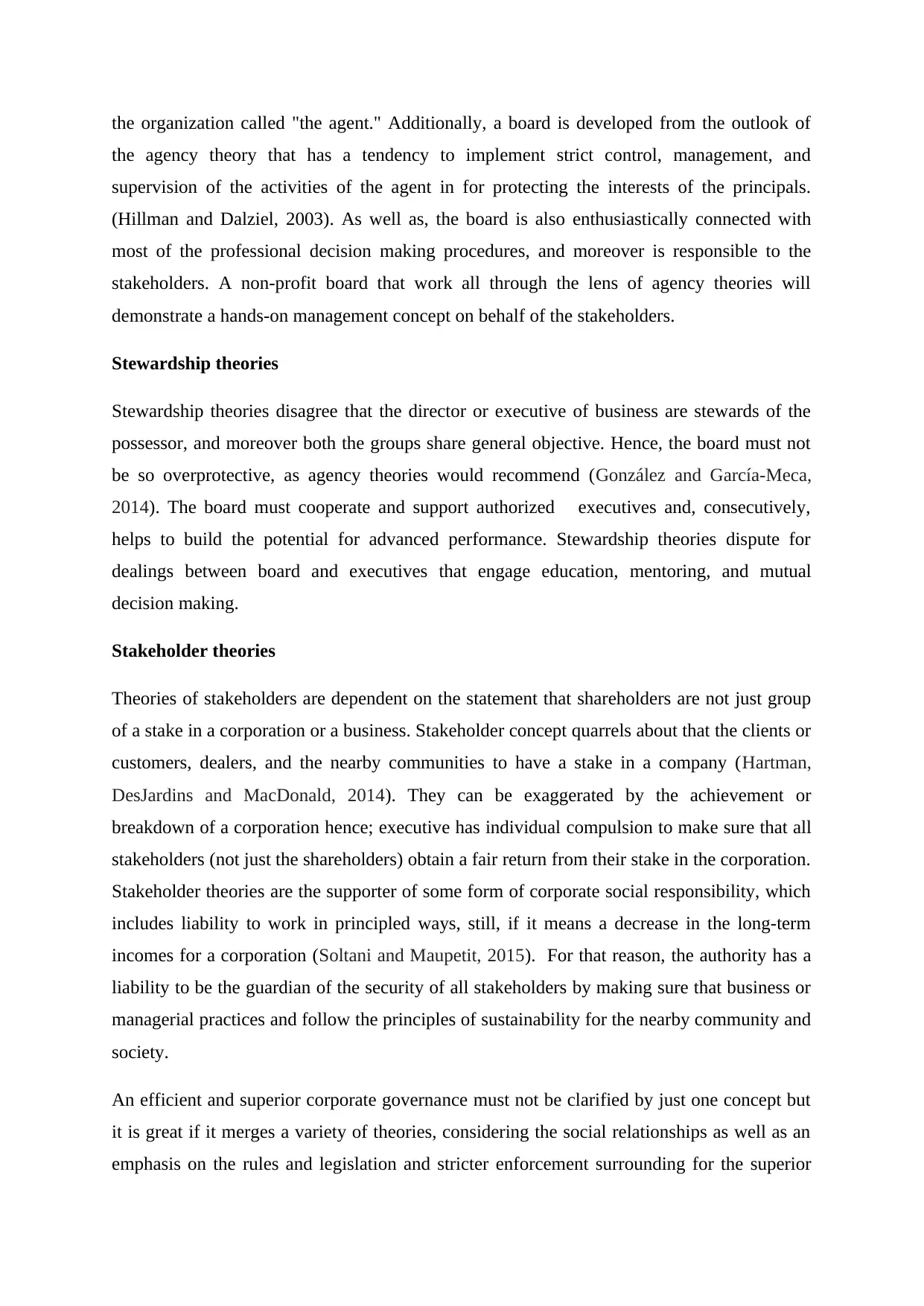
the organization called "the agent." Additionally, a board is developed from the outlook of
the agency theory that has a tendency to implement strict control, management, and
supervision of the activities of the agent in for protecting the interests of the principals.
(Hillman and Dalziel, 2003). As well as, the board is also enthusiastically connected with
most of the professional decision making procedures, and moreover is responsible to the
stakeholders. A non-profit board that work all through the lens of agency theories will
demonstrate a hands-on management concept on behalf of the stakeholders.
Stewardship theories
Stewardship theories disagree that the director or executive of business are stewards of the
possessor, and moreover both the groups share general objective. Hence, the board must not
be so overprotective, as agency theories would recommend (González and García-Meca,
2014). The board must cooperate and support authorized executives and, consecutively,
helps to build the potential for advanced performance. Stewardship theories dispute for
dealings between board and executives that engage education, mentoring, and mutual
decision making.
Stakeholder theories
Theories of stakeholders are dependent on the statement that shareholders are not just group
of a stake in a corporation or a business. Stakeholder concept quarrels about that the clients or
customers, dealers, and the nearby communities to have a stake in a company (Hartman,
DesJardins and MacDonald, 2014). They can be exaggerated by the achievement or
breakdown of a corporation hence; executive has individual compulsion to make sure that all
stakeholders (not just the shareholders) obtain a fair return from their stake in the corporation.
Stakeholder theories are the supporter of some form of corporate social responsibility, which
includes liability to work in principled ways, still, if it means a decrease in the long-term
incomes for a corporation (Soltani and Maupetit, 2015). For that reason, the authority has a
liability to be the guardian of the security of all stakeholders by making sure that business or
managerial practices and follow the principles of sustainability for the nearby community and
society.
An efficient and superior corporate governance must not be clarified by just one concept but
it is great if it merges a variety of theories, considering the social relationships as well as an
emphasis on the rules and legislation and stricter enforcement surrounding for the superior
the agency theory that has a tendency to implement strict control, management, and
supervision of the activities of the agent in for protecting the interests of the principals.
(Hillman and Dalziel, 2003). As well as, the board is also enthusiastically connected with
most of the professional decision making procedures, and moreover is responsible to the
stakeholders. A non-profit board that work all through the lens of agency theories will
demonstrate a hands-on management concept on behalf of the stakeholders.
Stewardship theories
Stewardship theories disagree that the director or executive of business are stewards of the
possessor, and moreover both the groups share general objective. Hence, the board must not
be so overprotective, as agency theories would recommend (González and García-Meca,
2014). The board must cooperate and support authorized executives and, consecutively,
helps to build the potential for advanced performance. Stewardship theories dispute for
dealings between board and executives that engage education, mentoring, and mutual
decision making.
Stakeholder theories
Theories of stakeholders are dependent on the statement that shareholders are not just group
of a stake in a corporation or a business. Stakeholder concept quarrels about that the clients or
customers, dealers, and the nearby communities to have a stake in a company (Hartman,
DesJardins and MacDonald, 2014). They can be exaggerated by the achievement or
breakdown of a corporation hence; executive has individual compulsion to make sure that all
stakeholders (not just the shareholders) obtain a fair return from their stake in the corporation.
Stakeholder theories are the supporter of some form of corporate social responsibility, which
includes liability to work in principled ways, still, if it means a decrease in the long-term
incomes for a corporation (Soltani and Maupetit, 2015). For that reason, the authority has a
liability to be the guardian of the security of all stakeholders by making sure that business or
managerial practices and follow the principles of sustainability for the nearby community and
society.
An efficient and superior corporate governance must not be clarified by just one concept but
it is great if it merges a variety of theories, considering the social relationships as well as an
emphasis on the rules and legislation and stricter enforcement surrounding for the superior
Paraphrase This Document
Need a fresh take? Get an instant paraphrase of this document with our AI Paraphraser
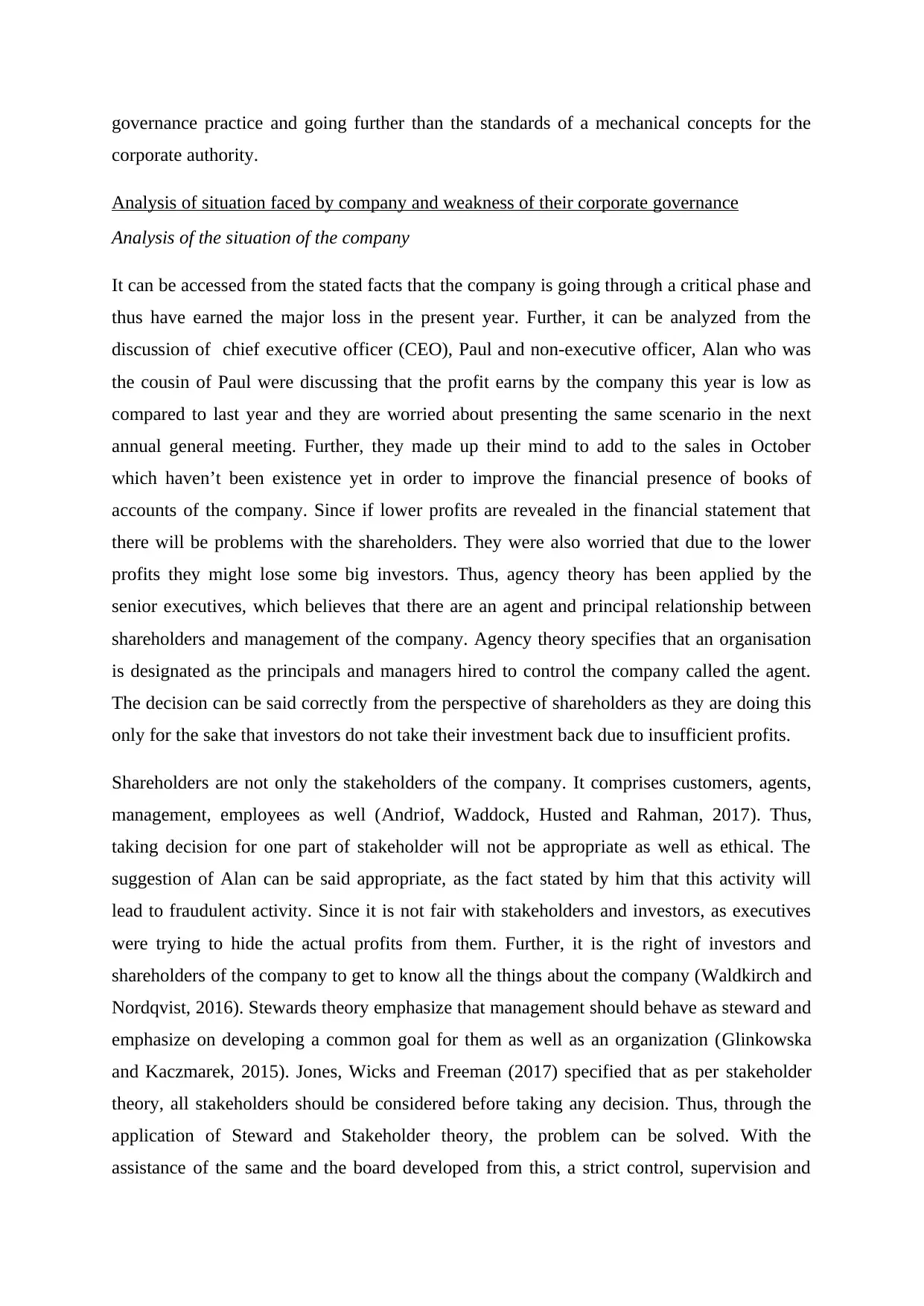
governance practice and going further than the standards of a mechanical concepts for the
corporate authority.
Analysis of situation faced by company and weakness of their corporate governance
Analysis of the situation of the company
It can be accessed from the stated facts that the company is going through a critical phase and
thus have earned the major loss in the present year. Further, it can be analyzed from the
discussion of chief executive officer (CEO), Paul and non-executive officer, Alan who was
the cousin of Paul were discussing that the profit earns by the company this year is low as
compared to last year and they are worried about presenting the same scenario in the next
annual general meeting. Further, they made up their mind to add to the sales in October
which haven’t been existence yet in order to improve the financial presence of books of
accounts of the company. Since if lower profits are revealed in the financial statement that
there will be problems with the shareholders. They were also worried that due to the lower
profits they might lose some big investors. Thus, agency theory has been applied by the
senior executives, which believes that there are an agent and principal relationship between
shareholders and management of the company. Agency theory specifies that an organisation
is designated as the principals and managers hired to control the company called the agent.
The decision can be said correctly from the perspective of shareholders as they are doing this
only for the sake that investors do not take their investment back due to insufficient profits.
Shareholders are not only the stakeholders of the company. It comprises customers, agents,
management, employees as well (Andriof, Waddock, Husted and Rahman, 2017). Thus,
taking decision for one part of stakeholder will not be appropriate as well as ethical. The
suggestion of Alan can be said appropriate, as the fact stated by him that this activity will
lead to fraudulent activity. Since it is not fair with stakeholders and investors, as executives
were trying to hide the actual profits from them. Further, it is the right of investors and
shareholders of the company to get to know all the things about the company (Waldkirch and
Nordqvist, 2016). Stewards theory emphasize that management should behave as steward and
emphasize on developing a common goal for them as well as an organization (Glinkowska
and Kaczmarek, 2015). Jones, Wicks and Freeman (2017) specified that as per stakeholder
theory, all stakeholders should be considered before taking any decision. Thus, through the
application of Steward and Stakeholder theory, the problem can be solved. With the
assistance of the same and the board developed from this, a strict control, supervision and
corporate authority.
Analysis of situation faced by company and weakness of their corporate governance
Analysis of the situation of the company
It can be accessed from the stated facts that the company is going through a critical phase and
thus have earned the major loss in the present year. Further, it can be analyzed from the
discussion of chief executive officer (CEO), Paul and non-executive officer, Alan who was
the cousin of Paul were discussing that the profit earns by the company this year is low as
compared to last year and they are worried about presenting the same scenario in the next
annual general meeting. Further, they made up their mind to add to the sales in October
which haven’t been existence yet in order to improve the financial presence of books of
accounts of the company. Since if lower profits are revealed in the financial statement that
there will be problems with the shareholders. They were also worried that due to the lower
profits they might lose some big investors. Thus, agency theory has been applied by the
senior executives, which believes that there are an agent and principal relationship between
shareholders and management of the company. Agency theory specifies that an organisation
is designated as the principals and managers hired to control the company called the agent.
The decision can be said correctly from the perspective of shareholders as they are doing this
only for the sake that investors do not take their investment back due to insufficient profits.
Shareholders are not only the stakeholders of the company. It comprises customers, agents,
management, employees as well (Andriof, Waddock, Husted and Rahman, 2017). Thus,
taking decision for one part of stakeholder will not be appropriate as well as ethical. The
suggestion of Alan can be said appropriate, as the fact stated by him that this activity will
lead to fraudulent activity. Since it is not fair with stakeholders and investors, as executives
were trying to hide the actual profits from them. Further, it is the right of investors and
shareholders of the company to get to know all the things about the company (Waldkirch and
Nordqvist, 2016). Stewards theory emphasize that management should behave as steward and
emphasize on developing a common goal for them as well as an organization (Glinkowska
and Kaczmarek, 2015). Jones, Wicks and Freeman (2017) specified that as per stakeholder
theory, all stakeholders should be considered before taking any decision. Thus, through the
application of Steward and Stakeholder theory, the problem can be solved. With the
assistance of the same and the board developed from this, a strict control, supervision and

observation of the performance of agent can be done so that the interest of principals can be
protected. Profit can be stated as the main factor which influences the decision of an investor.
Thus, the fear of executives of the organization is appropriate that they might lose big
investor as they haven’t performed well this year. However, presenting inappropriate profit is
not the solution. As it might lead to arising other difficulties if the truth is revealed afterwards
in front of stakeholders.
Weakness in the corporate governance of the company
By considering the case, it can be said that Paul and Alan are not following the proper
structure, which is not correct and acceptable, however, it is true that the corporate
governance does not possess exceptional design and is highly assessed as ambiguous, but it
should be ethical and supported by fairness and regulatory aspects (Weiss, 2014). With the
consideration towards case, as they are not following the corporate structure and are
considering the misinterpreted way of conducting financial statement, there is still
insufficient awareness regarding the several issues such as again relating to the case, fraud
manipulation and misconduct, as well the non-compliance towards the code of best practice
and the Board of Directors rights and duties. There have been various examples of scandalous
and failure in the sector of the company, as the case involved fraud due to their own benefit
while ignoring the code of ethics, accounting standards and laws. Since there was the
presence of poor or non-effective internal audits, inadequate needed managerial skills,
insufficient disclosures and non-adherence with justifiable aspects (Zadek, Evans and Pruzan,
2013). Considering the case, it can be noted that the corporate and Board of Directors are not
maintaining the disciples and are not pursuing the dignity and decorum of corporate due to
the non-acceptable involvement of contradictory and misleading aspects. Since company
policies are merely efficient as their adoption, the management of company provides high
efforts and contribution to developing the strategy, but in case they are not mobilized then
their initiatives will never be successful, so as in the case of Paul and Alan .
Thus, good company governance needs proper discipline and assurance towards the
implementation of strategies, commitment and policies. Speaking about the cited case, it can
be considered they have also not engaged transparency in their actions, as they are keeping
their own counsels, and are restricting the information that is required to be clarified to the
employees (Hartman, DesJardins and MacDonald, 2014). However, company transparency if
effectively used unites an organization, when the strategies are understood by the
protected. Profit can be stated as the main factor which influences the decision of an investor.
Thus, the fear of executives of the organization is appropriate that they might lose big
investor as they haven’t performed well this year. However, presenting inappropriate profit is
not the solution. As it might lead to arising other difficulties if the truth is revealed afterwards
in front of stakeholders.
Weakness in the corporate governance of the company
By considering the case, it can be said that Paul and Alan are not following the proper
structure, which is not correct and acceptable, however, it is true that the corporate
governance does not possess exceptional design and is highly assessed as ambiguous, but it
should be ethical and supported by fairness and regulatory aspects (Weiss, 2014). With the
consideration towards case, as they are not following the corporate structure and are
considering the misinterpreted way of conducting financial statement, there is still
insufficient awareness regarding the several issues such as again relating to the case, fraud
manipulation and misconduct, as well the non-compliance towards the code of best practice
and the Board of Directors rights and duties. There have been various examples of scandalous
and failure in the sector of the company, as the case involved fraud due to their own benefit
while ignoring the code of ethics, accounting standards and laws. Since there was the
presence of poor or non-effective internal audits, inadequate needed managerial skills,
insufficient disclosures and non-adherence with justifiable aspects (Zadek, Evans and Pruzan,
2013). Considering the case, it can be noted that the corporate and Board of Directors are not
maintaining the disciples and are not pursuing the dignity and decorum of corporate due to
the non-acceptable involvement of contradictory and misleading aspects. Since company
policies are merely efficient as their adoption, the management of company provides high
efforts and contribution to developing the strategy, but in case they are not mobilized then
their initiatives will never be successful, so as in the case of Paul and Alan .
Thus, good company governance needs proper discipline and assurance towards the
implementation of strategies, commitment and policies. Speaking about the cited case, it can
be considered they have also not engaged transparency in their actions, as they are keeping
their own counsels, and are restricting the information that is required to be clarified to the
employees (Hartman, DesJardins and MacDonald, 2014). However, company transparency if
effectively used unites an organization, when the strategies are understood by the
⊘ This is a preview!⊘
Do you want full access?
Subscribe today to unlock all pages.

Trusted by 1+ million students worldwide
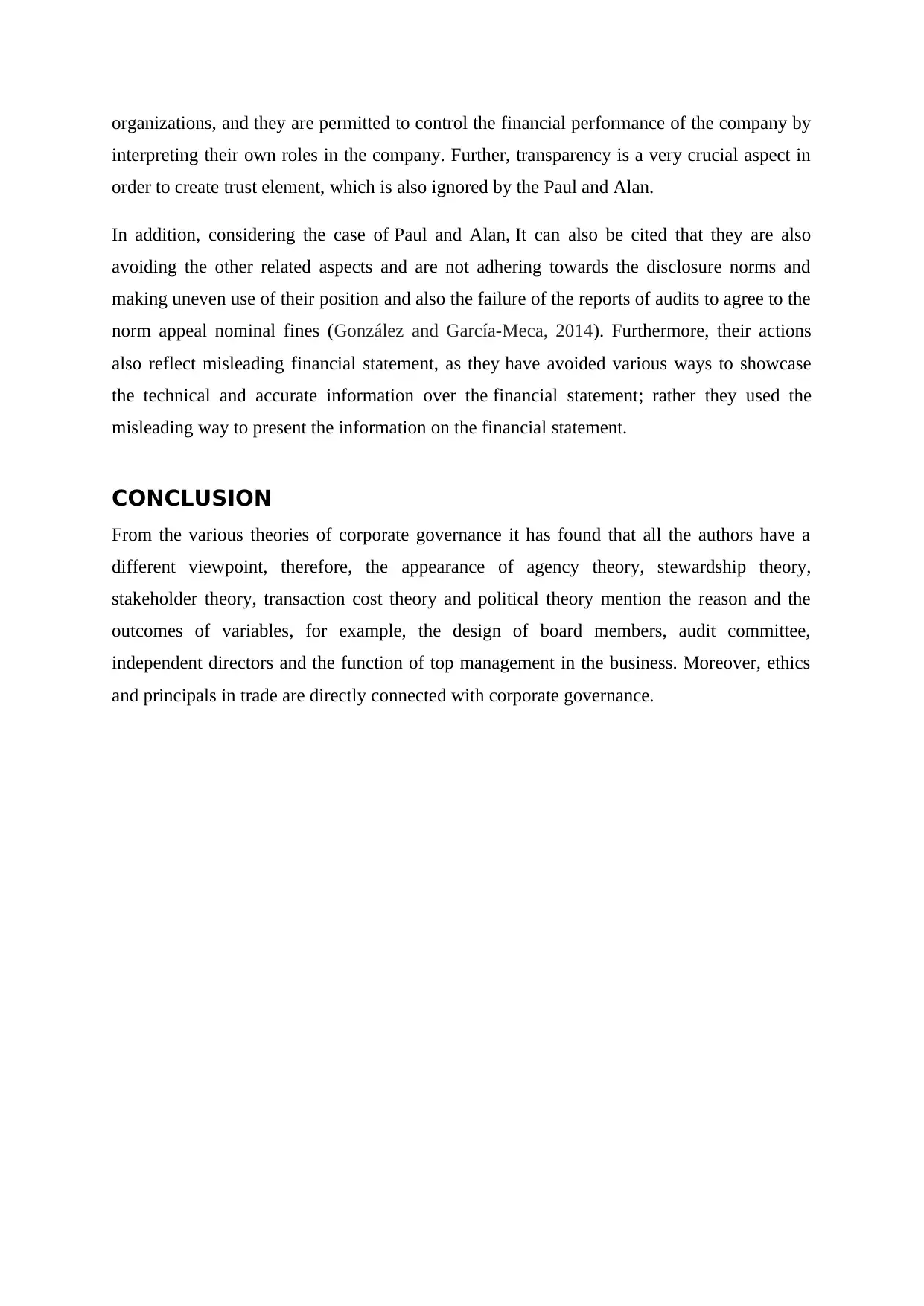
organizations, and they are permitted to control the financial performance of the company by
interpreting their own roles in the company. Further, transparency is a very crucial aspect in
order to create trust element, which is also ignored by the Paul and Alan.
In addition, considering the case of Paul and Alan, It can also be cited that they are also
avoiding the other related aspects and are not adhering towards the disclosure norms and
making uneven use of their position and also the failure of the reports of audits to agree to the
norm appeal nominal fines (González and García-Meca, 2014). Furthermore, their actions
also reflect misleading financial statement, as they have avoided various ways to showcase
the technical and accurate information over the financial statement; rather they used the
misleading way to present the information on the financial statement.
CONCLUSION
From the various theories of corporate governance it has found that all the authors have a
different viewpoint, therefore, the appearance of agency theory, stewardship theory,
stakeholder theory, transaction cost theory and political theory mention the reason and the
outcomes of variables, for example, the design of board members, audit committee,
independent directors and the function of top management in the business. Moreover, ethics
and principals in trade are directly connected with corporate governance.
interpreting their own roles in the company. Further, transparency is a very crucial aspect in
order to create trust element, which is also ignored by the Paul and Alan.
In addition, considering the case of Paul and Alan, It can also be cited that they are also
avoiding the other related aspects and are not adhering towards the disclosure norms and
making uneven use of their position and also the failure of the reports of audits to agree to the
norm appeal nominal fines (González and García-Meca, 2014). Furthermore, their actions
also reflect misleading financial statement, as they have avoided various ways to showcase
the technical and accurate information over the financial statement; rather they used the
misleading way to present the information on the financial statement.
CONCLUSION
From the various theories of corporate governance it has found that all the authors have a
different viewpoint, therefore, the appearance of agency theory, stewardship theory,
stakeholder theory, transaction cost theory and political theory mention the reason and the
outcomes of variables, for example, the design of board members, audit committee,
independent directors and the function of top management in the business. Moreover, ethics
and principals in trade are directly connected with corporate governance.
Paraphrase This Document
Need a fresh take? Get an instant paraphrase of this document with our AI Paraphraser

REFERENCES
Andriof, J., Waddock, S., Husted, B. and Rahman, S.S., (2017). Unfolding stakeholder
thinking 2: Relationships, communication, reporting and performance. Routledge.
Boubaker, S., and Nguyen, D. K (2014). Corporate Governance in Emerging Markets.
Berlin, Heidelberg: Springer Berlin Heidelberg. Retrieved from http://link. springer.
com/10.1007/978-3-642-44955-0
Dixon, J. and Frolova, Y. (2013). Accounting for good governance: the fair value
challenge. Corporate Governance: The international journal of business in
society. 13(3). 318-331.
Glinkowska, B. and Kaczmarek, B., (2015). Classical and modern concepts of corporate
governance (Stewardship Theory and Agency Theory). Management, 19(2), pp.84-92.
González, J. S. and García-Meca, E. (2014). Does corporate governance influence earnings
management in Latin American markets? Journal of Business Ethics. 121(3). 419-
440.
Hartman, L. P., DesJardins, J. R. and MacDonald, C. (2014). Business ethics: Decision
making for personal integrity and social responsibility. McGraw-Hill.
Jones, T.M., Wicks, A.C. and Freeman, R.E., (2017). Stakeholder theory: The state of the
art. The Blackwell guide to business ethics, pp.17-37.
Soltani, B. and Maupetit, C. (2015). Importance of core values of ethics, integrity and
accountability in the European corporate governance codes. Journal of Management
& Governance. 19(2). 259-284.
Waldkirch, M. and Nordqvist, M., (2016). the Case of stewardship theory. The Routledge
Companion to Family Business, p.401.
Weiss, J. W. (2014). Business ethics: A stakeholder and issues management approach.
Berrett-Koehler Publishers.
Zadek, S., Evans, R. and Pruzan, P. (2013). Building corporate accountability: Emerging
practice in social and ethical accounting and auditing. Routledge.
Andriof, J., Waddock, S., Husted, B. and Rahman, S.S., (2017). Unfolding stakeholder
thinking 2: Relationships, communication, reporting and performance. Routledge.
Boubaker, S., and Nguyen, D. K (2014). Corporate Governance in Emerging Markets.
Berlin, Heidelberg: Springer Berlin Heidelberg. Retrieved from http://link. springer.
com/10.1007/978-3-642-44955-0
Dixon, J. and Frolova, Y. (2013). Accounting for good governance: the fair value
challenge. Corporate Governance: The international journal of business in
society. 13(3). 318-331.
Glinkowska, B. and Kaczmarek, B., (2015). Classical and modern concepts of corporate
governance (Stewardship Theory and Agency Theory). Management, 19(2), pp.84-92.
González, J. S. and García-Meca, E. (2014). Does corporate governance influence earnings
management in Latin American markets? Journal of Business Ethics. 121(3). 419-
440.
Hartman, L. P., DesJardins, J. R. and MacDonald, C. (2014). Business ethics: Decision
making for personal integrity and social responsibility. McGraw-Hill.
Jones, T.M., Wicks, A.C. and Freeman, R.E., (2017). Stakeholder theory: The state of the
art. The Blackwell guide to business ethics, pp.17-37.
Soltani, B. and Maupetit, C. (2015). Importance of core values of ethics, integrity and
accountability in the European corporate governance codes. Journal of Management
& Governance. 19(2). 259-284.
Waldkirch, M. and Nordqvist, M., (2016). the Case of stewardship theory. The Routledge
Companion to Family Business, p.401.
Weiss, J. W. (2014). Business ethics: A stakeholder and issues management approach.
Berrett-Koehler Publishers.
Zadek, S., Evans, R. and Pruzan, P. (2013). Building corporate accountability: Emerging
practice in social and ethical accounting and auditing. Routledge.
1 out of 8
Related Documents
Your All-in-One AI-Powered Toolkit for Academic Success.
+13062052269
info@desklib.com
Available 24*7 on WhatsApp / Email
![[object Object]](/_next/static/media/star-bottom.7253800d.svg)
Unlock your academic potential
Copyright © 2020–2025 A2Z Services. All Rights Reserved. Developed and managed by ZUCOL.





